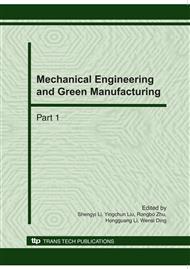p.1666
p.1671
p.1676
p.1681
p.1687
p.1692
p.1697
p.1702
p.1708
Effects and Mechanism of Titanium Modification on Shrinkage Cavity and Porosity of Cast Steel
Abstract:
The effects of titanium modification, which was added along with the pouring liquid in ladles, on the shrinkage porosity and cavity of cast steel ZG35 smelted in intermediate frequency induction furnace were studied. Proper content of titanium could effectively increase the volume of concentrated shrinkage cavity, and restrain the forming of shrinkage porosity. The concentrated shrinkage cavity was analyzed quantitatively by stuffing wet gluten and draining water method. The maximal cavity arrived at 0.15wt.% titanium modification. By scanning electron microscope (SEM) and energy disperse spectroscope (EDS) analysis, it was found that TiC, acting as heterogeneous nuclei, could refine the structure grains, diminish the strong dendrites, and increase the fluidity and feeding capacity of steel liquid. However, overdoes titanium modification easily caused mass nitrides or oxides, which kept solid phases with high meting point in metal liquid to increase its viscosity and decrease the fluidity. On the other hand, these solid state titanium compounds enlarged the composition supercooling, so the metal liquid changed from sequential solidification to simultaneous solidification, resulting in inadequate metal liquid feeding, less oncentrated shrinkage cavity and serious shrinkage porosity.
Info:
Periodical:
Pages:
1687-1691
Citation:
Online since:
October 2010
Authors:
Keywords:
Price:
Сopyright:
© 2010 Trans Tech Publications Ltd. All Rights Reserved
Share:
Citation:


